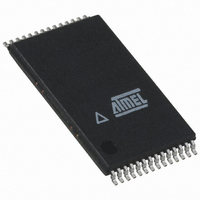ATMEGA8HVA-4TU Atmel, ATMEGA8HVA-4TU Datasheet - Page 28

ATMEGA8HVA-4TU
Manufacturer Part Number
ATMEGA8HVA-4TU
Description
MCU AVR 8K FLASH 4MHZ 28-TSOP
Manufacturer
Atmel
Series
AVR® ATmegar
Datasheet
1.ATMEGA16HVA-4CKU.pdf
(196 pages)
Specifications of ATMEGA8HVA-4TU
Core Processor
AVR
Core Size
8-Bit
Speed
4MHz
Connectivity
SPI
Peripherals
Brown-out Detect/Reset, POR, PWM, WDT
Number Of I /o
7
Program Memory Size
8KB (4K x 16)
Program Memory Type
FLASH
Eeprom Size
256 x 8
Ram Size
512 x 8
Voltage - Supply (vcc/vdd)
1.8 V ~ 9 V
Data Converters
A/D 5x12b
Oscillator Type
External
Operating Temperature
-20°C ~ 85°C
Package / Case
28-TSOP
For Use With
ATSTK600 - DEV KIT FOR AVR/AVR32ATSTK500 - PROGRAMMER AVR STARTER KIT
Lead Free Status / RoHS Status
Lead free / RoHS Compliant
- Current page: 28 of 196
- Download datasheet (3Mb)
9.11
9.12
9.12.1
9.12.2
28
VADC Clock Prescaler
OSI – Oscillator Sampling Interface
ATmega8HVA/16HVA
Features
Overview
The ripple counter that implements the prescaler runs at the frequency of the undivided clock,
may be faster than the CPU's clock frequency. It is not possible to determine the state of the
prescaler, and the exact time it takes to switch from one clock division to the other cannot be
exactly predicted. From the time the CLKPS values are written, it takes between T1 + T2 and T1
+ 2*T2 before the new clock frequency is active. In this interval, two active clock edges are pro-
duced. Here, T1 is the previous clock period, and T2 is the period corresponding to the new
prescaler setting.
To avoid unintentional changes of clock frequency, a special write procedure must be followed
to change the CLKPS bits:
1. Write the Clock Prescaler Change Enable (CLKPCE) bit to one and all other bits in
2. Within four cycles, write the desired value to CLKPS while writing a zero to CLKPCE.
Interrupts must be disabled when changing prescaler setting to make sure the write procedure is
not interrupted.
The VADC clock will be automatically prescaled relative to the System Clock Prescaler settings,
see
CLKPS1..0, the VADC clock, clk
page
•
•
•
•
The Oscillator Sampling Interface (OSI) enables sampling of the Slow RC and Ultra Low Power
RC (ULP) oscillators in ATmega8HVA/16HVA. OSI can be used to calibrate the Fast RC Oscilla-
tor runtime with high accuracy. OSI can also provide an accurate reference for compensating
the ULP Oscillator frequency drift.
The prescaled oscillator phase can be continuously read by the CPU through the OSICSR regis-
ter. In addition, the input capture function of Timer/Counter0 can be set up to trigger on the rising
edge of the prescaled clock. This enables accurate measurements of the oscillator frequencies
relative to the Fast RC Oscillator.
A simplified block diagram of the Oscillator Sampling Interface is shown in
29.
Runtime selectable oscillator input (Slow RC or ULP RC Oscillator)
7 bit prescaling of the selected oscillator
Software read access to the phase of the prescaled clock
Input capture trigger source for Timer/Counter0
CLKPR to zero.
”System Clock Prescaler” on page
32.
VADC
, will be prescaled by 4, 2 or 1 as shown in
27. Depending on the Clock Prescale Select bits,
Figure 9-2 on page
8024A–AVR–04/08
Table 9-4 on
Related parts for ATMEGA8HVA-4TU
Image
Part Number
Description
Manufacturer
Datasheet
Request
R

Part Number:
Description:
IC AVR MCU 2.4GHZ XCEIVER 64QFN
Manufacturer:
Atmel
Datasheet:

Part Number:
Description:
Manufacturer:
Atmel
Datasheet:

Part Number:
Description:
MCU ATMEGA644/AT86RF230 40-DIP
Manufacturer:
Atmel
Datasheet:

Part Number:
Description:
BUNDLE ATMEGA644P/AT86RF230 QFN
Manufacturer:
Atmel
Datasheet:

Part Number:
Description:
BUNDLE ATMEGA644P/AT86RF230 TQFP
Manufacturer:
Atmel
Datasheet:

Part Number:
Description:
MCU ATMEGA1281/AT86RF230 64-TQFP
Manufacturer:
Atmel
Datasheet:

Part Number:
Description:
MCU ATMEGA1280/AT86RF230 100TQFP
Manufacturer:
Atmel
Datasheet:

Part Number:
Description:
BUNDLE ATMEGA1280/AT86RF100-TQFP
Manufacturer:
Atmel
Datasheet:

Part Number:
Description:
BUNDLE ATMEGA2560V/AT86RF230-ZU
Manufacturer:
Atmel
Datasheet:

Part Number:
Description:
MCU ATMEGA2561/AT86RF230 64-TQFP
Manufacturer:
Atmel
Datasheet:

Part Number:
Description:
INTERVAL AND WIPE/WASH WIPER CONTROL IC WITH DELAY
Manufacturer:
ATMEL Corporation
Datasheet:

Part Number:
Description:
Low-Voltage Voice-Switched IC for Hands-Free Operation
Manufacturer:
ATMEL Corporation
Datasheet:

Part Number:
Description:
MONOLITHIC INTEGRATED FEATUREPHONE CIRCUIT
Manufacturer:
ATMEL Corporation
Datasheet:

Part Number:
Description:
AM-FM Receiver IC U4255BM-M
Manufacturer:
ATMEL Corporation
Datasheet:










